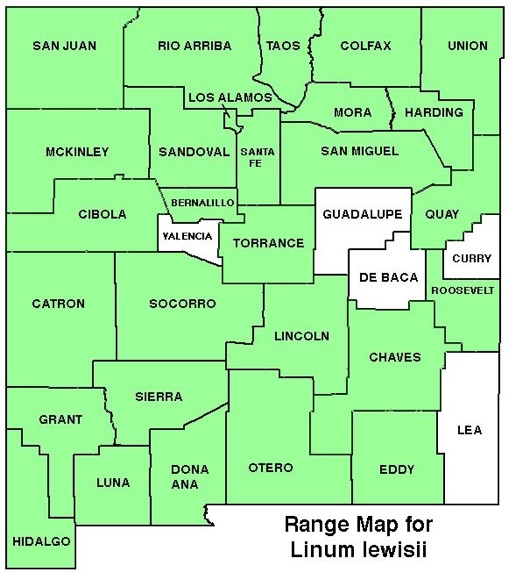WILDFLOWERS OF NEW MEXICO

This common roadside and garden flower reaches 1–2-feet tall with numerous slender, hairless, weakly erect to sprawling stems. Note the stems with narrow leaves and delicate blue flowers with yellow throats. The flowers bloom only one day, wilting by early afternoon, but numerous buds are waiting to open.
FLOWER: May–September. Flowers 1/2–1 inch (12–25 mm) wide have 5 petals, 3/8–5/8-inch (10–15 mm) long, that vary from light to dark blue, occasionally white, with dark lines radiating from a yellow center; styles shorter than the stamens,. Loose clusters of flowers bloom on one side of the stem with the upper buds drooping.
LEAVES: Alternate. Narrow, linear to lance-shaped, 3/16–1 3/16-inches (4–30 mm) long, to 3/16-inch (4 mm) wide, often hugging the stem.
HABITAT: Sandy, gravelly, clay, loam soils, roadsides, disturbed areas; meadows, plains, desert grasslands, pinyon-juniper-oak, mixed conifer-aspen woodlands.
ELEVATION: 5,000–12,000 feet.
RANGE: Widespread west of Mississippi River; Alaska, Canada.
SIMILAR SPECIES: Early spring-blooming Annual Meadow Flax, L. pratense, in nw counties and scattered elsewhere, is slightly smaller with petals less than 3/8-inch (10 mm) long, and styles shorter than the stamens. The other native flax in NM are yellow. The blue-flowering non-native Perennial Blue Flax, L. perenne and its cultivars, are popular in gardens and seed mixes for their long blooming season and as short-lived perennials that return in the spring. The cultivated annual Blue Flax L. usitatissimum, is one of the oldest crops in history. The stem fiber produces linen and the seeds are a nutritious source of omega-3 fatty acids and linseed oil. The annual flax has more chromosomes than the perennials and produces twice as much seed oil.
NM COUNTIES: Statewide at mid- to high-elevations, except Curry, De Baca, Guadalupe, Lea, Valencia.

BLUE FLAX
LINUM LEWISII
Flax Family, Linaceae
Perennial herb

THE CONTENTS OF THIS WEBSITE ARE COPYRIGHTED AND CANNOT BE USED
WITHOUT PERMISSION OF GEORGE OXFORD MILLER






Leaves are alternate, narrow, linear to lance-shaped, often hugging the stem.

EMAIL ME